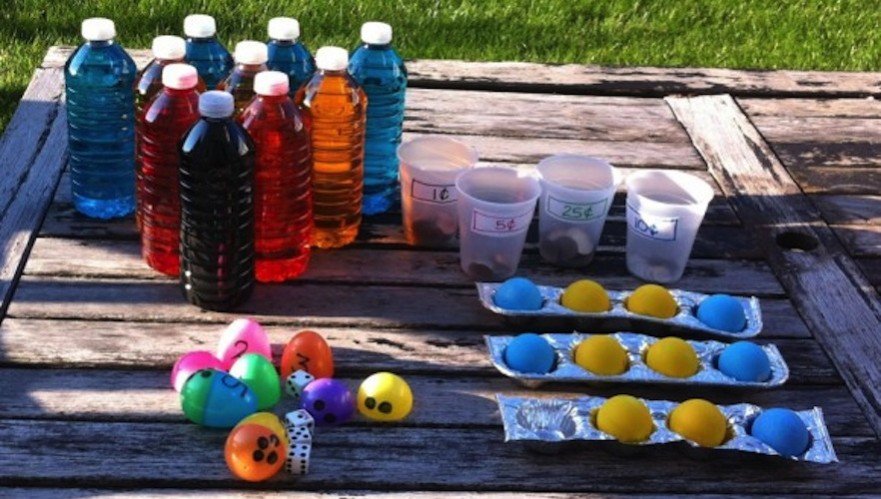Making Math Fun: 5 DIY Activities and Games
(Featured above, are all of the math games.)
by Beth Engelman
Build math skills and have fun with these playful, DIY activities. Perfect for the age range of 4-7.
Ping Pong Patterns
Go pattern crazy with this activity that teaches kids how to identify, extend, and create patterns.
You Need:
- 12 Ping Pong Balls
- Paint (different colors)
- Aluminum Muffin Tin with 12 Openings (egg cartons work equally as well)
Directions:
- Paint ping pong balls as desired, making sure you use each color at least 3 times.
- Cut muffin tin into narrow columns, so that each row has 4 openings.
- Work with your kids to make patterns by placing different colored balls in the muffin tin. At first, keep the patterns simple by alternating two colors, but as soon as that skill is mastered move on to include more colors and complex patterns. As your child grows more confident, add new attributes to the balls such as stripes, letters or numbers.
Greater Than / Less Than Dice Game
Nurture an understanding of “greater than,” “less than” and “equal to,” with a roll of the dice and a few M&M’s.
You Need:
- A Pair of Dice (each player gets one die)
- M&M Candies
Directions:
- Players roll their die at the same time.
- The person with the higher number “wins” the round and “wins” one M&M (set aside until the game is over).
- If the players each roll the same number, both players win an M&M.
- Continue game until 10 rounds are played.
- The person with the most M&M’s at the end of the game wins (and gets the candy!).
- To make this game more challenging, give each player two dice, which will also introduce the concept of simple addition.
Number-Symbol Match-It!
One of the most important math concepts young children must master is the connection between a quantity and it’s corresponding numeral. The following game is a great way to help kids understand the number-symbol connection in a very concrete way.
You Need:
- 5 Plastic Eggs
- Sharpie Marker
- Empty Shoebox or Basket
Directions:
- Open eggs and place all the halves on a table.
- Write a numeral (1-5) on the top half of each egg.
- Draw groups (1-5) of polka dots on the bottom half of each egg.
- Place all the egg halves in a shoebox and shake them around.
- Ask your kids match the top eggs (the numeral) with their corresponding bottom half (number of polka dots). As your kids grow more proficient, add more eggs with larger numbers.
Water Bottle Bowling
Bowling is one of the best ways to reinforce the “Make 10” strategy, which is a key when solving addition and subtraction problems. Even if your kids are not yet ready for simple addition and subtraction, they can still benefit from learning about number pairings that “make 10,” or in this case bowling pins that “make 10.”
You Need:
- 10 Plastic Water Bottles (filled with water)
- Food Coloring (optional)
- Medium Weight Ball
Directions:
- If desired, add food coloring to water bottles to make “bowling pins” more vibrant.
- Set up pins by grouping them in rows of 4,3,2, and 1.
- Just like a traditional bowling game, each player gets 2 changes to knock down all 10 pins.
- After each initial roll, ask your kids to tell you how many pins they knocked down and how many more they need to hit to knock them all over. The more you play the more your kids will remember the pairs that make 10.
Cool Change
Introduce the concept of money and organizing your piggy bank with this sorting activity. As with all small objects, coins can be a choking hazard so this game is not recommended for kids under 4-years-old and it should always be played with adult supervision.
You Need:
- 4 Plastic Cups (labeled 1¢, 5¢, 10¢, 25¢)
- Assorted Coins
Directions:
- Place coins in a bowl next to labeled cups.
- Show your kids the difference between a penny, nickel, dime and quarter.
- Have kids sort change into different cups.
- Make this an ongoing activity by having your kids sort your loose change once a week. As your kids’ math skills improve you can teach them how to count the coins by categories, which will also strengthen their skip counting skills.
Beth Engelman, M.Ed. is a former kindergarten teacher. Her math ideas and games have been published in a number of publications. She is also the author of several “edutainment” books and games including a series of workbooks for Disney Schoolhouse. Find inspiring ideas on her blog, Mommy on a Shoestring.
Please share any thoughts or questions you might have below in the comments section. We love hearing from you!
The Mother Company aims to support parents and their children, providing thought-provoking web content and products based in social and emotional learning for children ages 3-6. Check out episodes of our “Ruby’s Studio” children’s video series, along with our beautiful children’s books, apps, music, handmade dolls, and more.
Posted in: Expert Advice, Parental Wisdom
